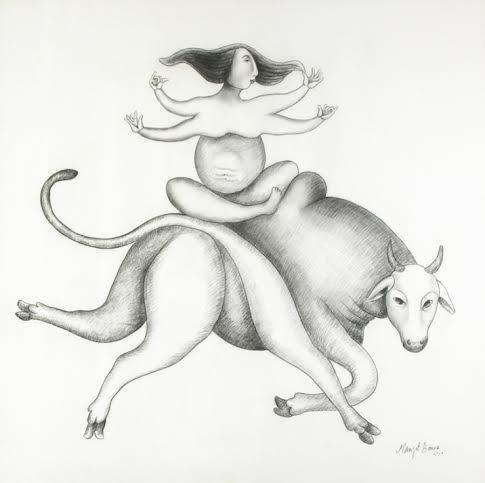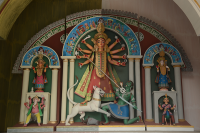 Shiva on a Bull, courtesy Chhatrapati Shivaji Maharaj Vastu Sangrahalaya A drawing by painter Susanta Paral
Shiva on a Bull, courtesy Chhatrapati Shivaji Maharaj Vastu Sangrahalaya A drawing by painter Susanta Paral
Sylvan historian with a pencil
Does drawing as an art form still appeal? Has drawing as an art form that goes back to the time of the growth of human civilisation really reached the last frontier? Uttara Gangopadhyay explores
A look at art exhibitions around us reveals that painting and the newer arts could have relegated drawing to the periphery of the artistic world. While commercial and industrial art flourish in their own domains owing to their utility, there has been a growing concern that drawing as a finished art form is on the wane. In his preface to the book Indian Drawing Today, Ram Chatterji, says, “Examples of drawing as end product though not unknown, are not as numerous as those of paintings.” According to him, drawing is “either used as a preliminary for a painting, or as a record of visual or mutual experience, for possible use as a reference or as aide-memoire.”
If one looks at major art exhibitions, or even auctions, it seems finished drawing is fighting for existence among paintings, sculptures, and the ever widening world of newer arts.
Yet, give a pencil or a pastel stick to an untutored child and he or she will invariably draw a line or two, make a squiggle or draw any shape. This may not indicate the child’s future as an artist but it does indicate that human beings take to drawing instinctively, knowingly or unknowingly. Although the jury is still out deciding whether it is this basic urge for expression that compelled cave dwellers in the stone ages to draw on the walls, the cave drawings are critical to our understanding about the life of the earliest human races. Besides, folk and tribal art, India is home to a unique legacy – ritualistic art expressed through the execution of alpana or aripana. Exigencies even inspired artists to invent. A popular medium for drawing today, the Conté crayon - made of compressed powdered graphite or charcoal mixed with a base of wax or clay - was invented in 1795 by Nicolas-Jacques Conté, as Napoleonic Wars had led to a shortage of graphite. One can thus easily say that drawing has been the ‘sylvan historian’ of human civilisation.
“Drawings hold the secret to art but we often tend to see them as secondary to finished art,” explained well known artist Sudhir Patwardhan as he guided the visiting art lovers around the Jehangir Nicholson Art Gallery. It was a revelation to see how artists, who we know more as painters, sculptors, etc., have executed drawings as finished art.With its root embedded in expressions through simple lines, drawing – like any other art form – has evolved over the years as artists introduced new methods and styles, broke a few classical rules and interwove modernist ideas from other forms of art to enhance drawing..jpg)
Located in Mumbai’s Chhatrapati Shivaji Maharaj Vastu Sangrahalaya (formerly the Prince of Wales Museum), the gallery was holding an exhibition of select drawings from the collection of industrialist and former sheriff of Mumbai, Jehangir Nicholson (1915-2001). Inspired by artist Paul Klee’s remark that ‘a line is a dot that goes for a walk’, curator Kamini Sahwney said, “We have called the exhibition Taking the Line for a Walk, to turn the spotlight on drawing.” The exhibition showcased ( till this August end) how leading modern artists have interpreted drawing in their own ways, experimenting with styles and forms, adding mass, tone and shading to create exquisite art.Through simple linear expressions to cubism, these artists have really taken the line for a walk.
The exhibition displayed 45 drawings made by India’s leading artists, old and young; Chittoprasad Bhattacharya, MF Hussain, Jatin Das, Nikhil Biswas, Tyeb Mehta, Ganesh Pyne, FN Souza, SH Raza, Arpana Caur, Laxman Shreshta, Manjit Bawa, to name a few; there was even a drawing by Homi J Bhaba.
It was revelation to find how complex painters and sculptors such as Ramkinkar Baij and Sadanand Bakre, have wielded their pencil or pen; in apparently simply executed lines, their drawings depict women in varying moods -thoughtful, confident. Manjit Bawa’s depiction of animal forms in the drawing Shiva on a Bull in comparison to Paritosh Sen’s drawing of a Gorilla. And then you find that Vasudeo Gaitonde’s drawing teases the viewer with an expression in abstraction – he has used the form of an ancient script – lines and spheres – to create the idea of writing, yet saying nothing. Apparently, artists use the same flexibility with their drawings as they do with their paintings, as Patawardhan’s representation of a Dying City revealed in contrast to Raza’s 1953 untitled drawing of houses with a church in the background.
Going by the extent of time stamps and the list of artists, the exhibition has definitely proved that drawing, even in its modest presence, is still a favourite form of expression and will hold its own against the onslaught of new arts, because- as artist Krishen Khanna aptly says, “Drawing is a spontaneous act. The weight of the matter does not obtrude… a sheet of paper, a pencil, pen or crayon, is enough.”
Images: Shiva on a Bull, courtesy Chhatrapati Shivaji Maharaj Vastu Sangrahalaya
A drawing by painter Susanta Paral
Top Headlines
-
Art and Culture
Beyond Old and New: Bickram Ghosh and the Art of Fusion at Serendipity
December 25, 2025
-
Art and Culture
Saptak Music School of Pittsburgh hosts spellbinding evening of Indian classical music
September 23, 2025
-
Art and Culture
Zigzag to clarity: Sonal Mansinghs dance of life captivates Delhi
September 08, 2025
-
Art and Culture
USA: Santoor Ashram Kolkata mesmerises Los Angeles with a celebration of Indian classical music
August 27, 2025
-
Art and Culture
'Feels like a tonic in my musical pursuits': Flute virtuoso Pandit Ronu Majumdar receives Padma Shri
June 06, 2025
-
Art and Culture
Of Paris, a chronic pain and a pivotal friendship: Frida Kahlo meets Mary Reynolds at the Art Institute of Chicago
April 16, 2025
-
Art and Culture
Prabha Khaitan Foundation celebrates 'Vasant Utsav' at Indian Museum Kolkata
March 15, 2025
-
Art and Culture
Musical concert 'Ami Bhalobashi Bangla Ke' to be held in Kolkata on April 19
February 20, 2025
-
Art and Culture
A kiss in front of The Kiss? Vienna museum's V-Day offer is ode to Klimt's artistic masterpiece
February 10, 2025
-
Art and Culture
Dalhousie Square: Timekeeping with Kolkata's British gems
January 12, 2025

